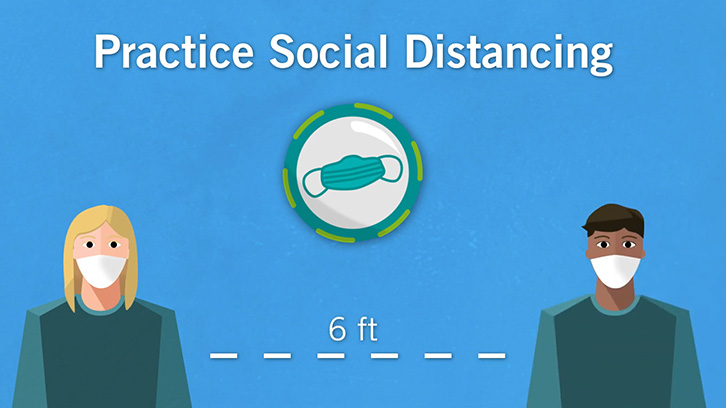A Pathway Forward: Social Distancing, Face Coverings and Potential Vaccines

The past several months have been a mix of optimism, confusion, and steps forward on a return to some degree of normalcy. Unfortunately, progress has been halted or reversed by a lack of clear guidance and understanding, or perhaps acceptance, of the manner in which the SARS-CoV-2 is transmitted. Guidance from the World Health Organization and Centers for Disease Control has failed to recognize the evidence that the transmission of the virus and spread of infection are likely related to aerosolization of the virus.
This reluctance to acknowledge scientific evidence, along with the politicization of the use of face coverings and the resultant inadequate public health strategy to address the pandemic, has allowed continued spread of the virus. We now have a monumental loss of more than 200,000 Americans to COVID-19. Even if your family has not personally experienced the loss of a loved one, I am certain their lives have been directly impacted by social isolation, disruption of the economy, and pervasive anxiety caused by the current chaos.
In order to address the pandemic head-on and do all we can to recover from it, we need to accept and act upon the overwhelming scientific evidence about SARS-CoV-2, which continues to evolve each and every day.
SARS-CoV-2 is transmitted or spread via airborne droplets (aerosolization)!1,2
Acknowledging this fact is the basis for reducing the transmission of the virus and forms the rationale for social distancing and using face coverings. It should guide national, regional and local strategies to reduce transmission of the virus and save lives.
A large percentage of infected individuals of all ages are asymptomatic and contagious, and they are propagating the pandemic.
Infection with the SARS-Co-V-2 virus affects different people in different ways, just like virtually all other infections. Conservative estimates from the Johns Hopkins University of Medicine Coronavirus Resource Center document 6,859,117 cases leading to 199,911 deaths, a mortality rate nearly three times that of Influenza (flu).
Some individuals are asymptomatic, some have mild to moderate symptoms, and some progress to overwhelming injury leading to death. The long-term health impact is poorly understood, but a complete recovery is unlikely if the experience with other viruses applies. An ongoing question for our community is whether or not there is permanent damage in those with mild or moderate COVID-19. The answer remains unclear for those individuals, but it is clear that in those with severe COVID-19 and respiratory failure, fibroproliferative Acute Respiratory Distress Syndrome (ARDS) can occur with resultant fibrosis. This type of lung scarring is different from that seen in our interstitial lung disease community, as it is less commonly progressive but has a devastating impact on those affected patients and families for months to years to come.
We know that the SARS-CoV-2 virus can be transmitted by aerosolization, carried by asymptomatic individuals, and devastate specific at-risk individuals, as well as otherwise healthy persons. Therefore, common sense steps must be taken to reduce the spread of the virus and its impact. These everyday precautions include:
1. Physical (social) distancing of 6 feet at a minimum. More distance is even better. One cannot get infected with the virus if one is not exposed!
a. If routine, regular universal testing is available, then we know who is infected and temporary, appropriate quarantines should be imposed. In that setting, these restrictions could be modified similar to the National Basketball Association “bubble,” allowing for appropriate social interactions moving forward.
2. Face coverings reduce the spread of the virus and are effective!
a. If you wear a mask and I wear a mask during a doctor’s appointment or within the hospital, the risk of transmission of the SARS-CoV-2 virus is dramatically reduced. Logic then suggests that a similar situation occurs in the grocery store, a restaurant, or caring for a family member. A mask is not a political statement. It is an act of kindness and demonstration that you respect your life and the lives of those around you.
3. Vaccination, in addition to physical distancing and the use of face coverings, is the next step forward to allowing us to co-exist with the SARS-CoV-2 virus and COVID-19, in contrast to the lives we are currently leading. The use of any vaccine is contingent on two principles: 1.) safety, and 2.) effectiveness in preventing or reducing the transmission of the virus or reducing the consequences of developing COVID-19 and of death. Importantly, being vaccinated is not a political vote, it is your way of protecting you, your family, friends, and community.
We have a clear pathway out of the pandemic which includes the combination of physical distancing and appropriate face coverings, routine and regular testing for SARS-CoV-2, and utilization of a safe and effective vaccine when available. If each of us does our part, we can be protected from the virus and cope with the threat it presents. We can then carry on without the fear of a persistent pandemic.
1. Zhang R, Li Y, Zhang AL, Wang Y, Molina MJ. Identifying airborne transmission as the dominant route for the spread of COVID-19. Proceedings of the National Academy of Sciences of the United States of America. 2020;117(26):14857-14863.
2. de Man P, Paltansing S, Ong DSY, Vaessen N, van Nielen G, Koeleman JGM. Outbreak of COVID-19 in a nursing home associated with aerosol transmission as a result of inadequate ventilation. Clin Infect Dis. 2020.
